The shift from in-hospital to remote patient care is opening up the competitive landscape and allowing smaller, more agile and innovative companies to create novel solutions. Many of these solutions combine wearables with advanced software that can help detect, cure and prevent diseases. While wearable devices are responsible for capturing patient data, advancements in artificial intelligence and machine learning put software at the heart of application innovation. However, the integration of hardware is not easy if you’re in the software business, especially since many medical wearable devices are proprietary and closed systems.
View the agenda from the complimentary web seminar | Wearables: The Small Parts Drive Innovation (October 15, 2019) and listen on-demandTo remove the barriers to remote patient monitoring (RPM) solutions, we need to empower application developers since diagnostic and preventive solutions will likely happen at the data analysis level—incorporating multiple data points with complex algorithms. To do this, wearable sensors need to be abstracted into a simplified and easy to integrate platform so that developers can focus on the application. This is somewhat like the personal computer era when operating systems and databases were made easier and more accessible for developers, which then produced a myriad of lower cost, innovative applications for industry and consumers alike. To help developers with this obstacle, VivaLNK created a Medical Sensor Platform designed to ease their job by combining wearable sensors with data connectivity options for virtually any type of application.
This new approach to medical application development helps healthcare solution providers and developers accelerate time-to-market by leveraging interoperable hardware and software components to capture patient data from any location, and easily integrate that data with their application for analysis at the edge or in the cloud. The solution abstracts the wearable sensor, network, and data infrastructure from the application, which allow developers to focus on their specific domain whether it’s congestive heart failure detection, chemo treatment infection monitoring, or bedside patient deterioration monitoring. The sensors are abstracted from the application through a common protocol that makes integrating with multiple sensors simpler. In addition, ensuring reliable data transfer such as during a network failure, between the sensor and application is handled within the protocol instead of requiring the developer to put in the application itself.
The ability to easily integrate hardware and software into a single solution solves a variety of issues for developers so they can focus on their specific medical application. Just as open systems and APIs accelerated the development of applications in the IT industry, the same is happening and needs to continue to happen in the medical technology world. This is just the beginning in getting more cost effective solutions into the RPM market faster.







